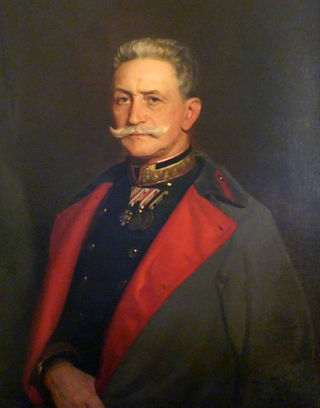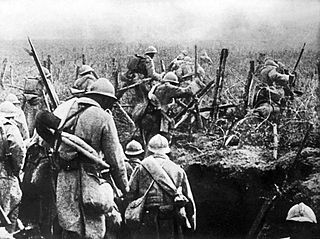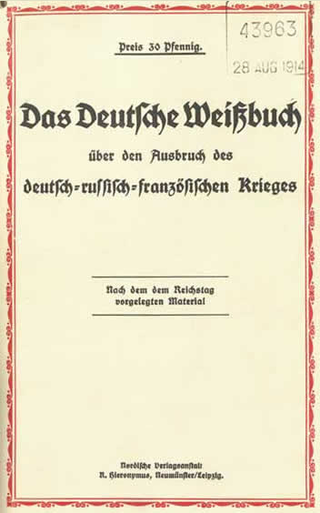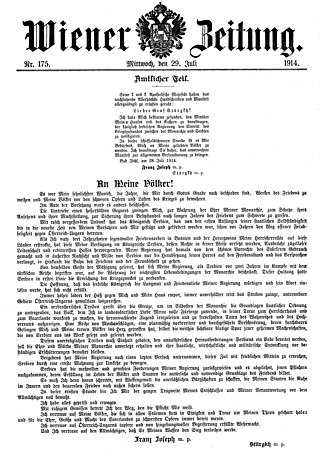
Austria-Hungary, often referred to as the Austro-Hungarian Empire or the Dual Monarchy, was a multi-national constitutional monarchy in Central Europe between 1867 and 1918. Austria-Hungary was a military and diplomatic alliance of two sovereign states with a single monarch who was titled both emperor of Austria and King of Hungary. Austria-Hungary constituted the last phase in the constitutional evolution of the Habsburg monarchy: it was formed with the Austro-Hungarian Compromise of 1867 in the aftermath of the Austro-Prussian War and was dissolved shortly after Hungary terminated the union with Austria on 31 October 1918.

The Central Powers, also known as the Central Empires, were one of the two main coalitions that fought in World War I (1914–1918). It consisted of the German Empire, Austria-Hungary, the Ottoman Empire, and Bulgaria; this was also known as the Quadruple Alliance.

Franz Xaver Josef Conrad von Hötzendorf, sometimes anglicised as Hoetzendorf, was an Austrian general who played a central role in World War I. He served as K.u.k. Feldmarschall and Chief of the General Staff of the military of the Austro-Hungarian Army and Navy from 1906 to 1917. He was in charge during the July Crisis of 1914 that caused World War I.

Gottlieb von Jagow was a German diplomat. He served as the State Secretary of the German Foreign Office between January 1913 and 1916.

The Eastern Front or Eastern Theater of World War I was a theater of operations that encompassed at its greatest extent the entire frontier between Russia and Romania on one side and Austria-Hungary, Bulgaria, the Ottoman Empire, and Germany on the other. It ranged from the Baltic Sea in the north to the Black Sea in the south, involved most of Eastern Europe, and stretched deep into Central Europe. The term contrasts with the Western Front, which was being fought in Belgium and France.

The identification of the causes of World War I remains a debated issue. World War I began in the Balkans on July 28, 1914, and hostilities ended on November 11, 1918, leaving 17 million dead and 25 million wounded. Moreover, the Russian Civil War can in many ways be considered a continuation of World War I, as can various other conflicts in the direct aftermath of 1918.

The Entente, or the Allies, were an international military coalition of countries led by France, the United Kingdom, Russia, the United States, Italy, and Japan against the Central Powers of Germany, Austria-Hungary, the Ottoman Empire, and Bulgaria in World War I (1914–1918).

The Serbian campaign was a series of military expeditions launched in 1914 and 1915 by the Central Powers against the Kingdom of Serbia during the First World War.

World War I or the First World War was a global conflict between two coalitions: the Allies and the Central Powers. Fighting took place throughout Europe, the Middle East, Africa, the Pacific, and parts of Asia. One of the deadliest wars in history, it resulted in an estimated 9 million soldiers dead and 23 million wounded, plus up to 8 million civilian deaths from numerous causes including genocide. The movement of large numbers of troops and civilians during the war was a major factor in spreading the 1918 Spanish flu pandemic.
The following outline is provided as an overview of and topical guide to World War I:
Historians writing about the origins of World War I have differed over the relative emphasis they place upon the factors involved. Changes in historical arguments over time are in part related to the delayed availability of classified historical archives. The deepest distinction among historians remains between those who focus on the actions of Germany and Austria-Hungary as key and those who focus on a wider group of actors. Meanwhile some historians, such as Fritz Fischer, maintain that Germany deliberately sought war while others do not. The main distinction among the latter is between those who believe that a war between the "Great Powers" was ultimately unplanned but still caused principally by Germany and Austria-Hungary taking risks, and those who believe that either all or some of the other powers, namely Russia, France, Serbia and Great Britain, played a more significant role in risking war than had been traditionally suggested.

World War I was the first war in which mass media and propaganda played a significant role in keeping the people at home informed on what occurred at the battlefields. It was also the first war in which governments systematically produced propaganda as a way to target the public and alter their opinion.

The German White Book was a publication by the German government of 1914 documenting their claims for the causes of World War I. The full title was "The German White Book about the outbreak of the German-Russian-French war". An authorized English translation appeared in 1914. The book contained extracts of diplomatic material intended to portray the war's cause to other sources.
The diplomatic history of World War I covers the non-military interactions among the major players during World War I. For the domestic histories of participants see home front during World War I. For a longer-term perspective see international relations (1814–1919) and causes of World War I. For the following (post-war) era see international relations (1919–1939). The major "Allies" grouping included Great Britain and its empire, France, Russia, Italy and the United States. Opposing the Allies, the major Central Powers included Germany, Austria-Hungary, the Ottoman Empire (Turkey) and Bulgaria. Other countries also joined the Allies. For a detailed chronology see timeline of World War I.

France entered World War I when Germany declared war on 3 August 1914.

Germany entered into World War I on August 1, 1914, when it declared war on Russia. In accordance with its war plan, it ignored Russia and moved first against France–declaring war on August 3 and sending its main armies through Belgium to capture Paris from the north. The German invasion of Belgium caused Britain to declare war on Germany on August 4. Most of the main parties were now at war. In October 1914, Turkey joined the war on Germany's side, becoming part of the Central Powers. Italy, which was allied with Germany and Austria-Hungary before World War I, was neutral in 1914 before switching to the Allied side in May 1915.

On 28 July 1914, Austria-Hungary declared war on Serbia because of the Assassination of Archduke Franz Ferdinand. Within days, long-standing mobilization plans went into effect to initiate invasions or guard against them and Russia, France and Britain stood arrayed against Austria and Germany in what at the time was called the "Great War", and was later named "World War I" or the "First World War". Austria thought in terms of one small limited war involving just the two countries. It did not plan a wider war such as exploded in a matter of days.

The Russian Empire's entry into World War I unfolded gradually in the days leading up to July 28, 1914. The sequence of events began with Austria-Hungary's declaration of war on Serbia, a Russian ally. In response, Russia issued an ultimatum to Vienna via Saint Petersburg, warning Austria-Hungary against attacking Serbia. As the conflict escalated with the invasion of Serbia, Russia commenced mobilizing its reserve army along the border of Austria-Hungary. Consequently, on July 31, Germany demanded that Russia demobilize. When Russia did not comply, Germany declared war on Russia on August 1, 1914. According to its war plan, Germany prioritized its offensive against France, declaring war on August 3. Germany deployed its main armies through Belgium with the aim of encircling Paris. The imminent threat to Belgium prompted Britain to declare war on Germany on August 4. The Ottoman Empire subsequently joined the Central Powers and engaged in warfare against Russia along their shared border.

Italy entered into the First World War in 1915 with the aim of completing national unity: for this reason, the Italian intervention in the First World War is also considered the Fourth Italian War of Independence, in a historiographical perspective that identifies in the latter the conclusion of the unification of Italy, whose military actions began during the revolutions of 1848 with the First Italian War of Independence.

In diplomatic history, a color book is an officially sanctioned collection of diplomatic correspondence and other documents published by a government for educational or political reasons, or to promote the government position on current or past events. The earliest were the British Blue Books, dating to the 17th century. In World War I, all the major powers had their own color book, such as the German White Book, the Austrian Red Book, Russian Orange Book, and more.















